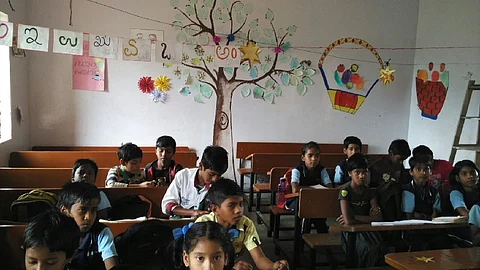

What started as a spot-fixing exercise for the Nallurahalli Rising volunteers ended up as a first step towards working for a social cause.
The members of the citizen welfare group revived an abandoned government school to educate the children of migrant labourers living in the small pockets in the villages around one of Bengaluru’s IT hub, Whitefield.
“The resources are all around us, we just need to learn to identify how they can be put to appropriate use,” says a Nallurahalli Rising member, Murugaraj.
A before and after image of the school
The bridge school will help the 125 children catch up with the years of education they lost
The group had informed Samridhdhi Trust, a 5-year old non-profit organisation that focuses on enabling children to access holistic education.
The trust took up the project of starting the Nallurahalli bridge school, their seventh project in Bengaluru. Apart from teaching these children, Samridhdhi also arranges for transportation to bring children from four villages around the area.
Mom Bannerjee, the Founder of the organisation says, “We are present in three cities, Pune, Noida and Bengaluru, which have been seeing a lot of growth in the last few years and have many slum-like areas in pockets of the city. These were temporary establishments of migrant labourers. These children would do menial jobs like picking garbage, the older children would take care of chores and siblings while their parents are at work.”
Nallurahalli bridge school that started with 50 children in August now has about 125 students coming from villages within four kilometres radius. The school is in a tie-up with a government school that shares the “Akshaya Patra” mid-day meals thrice a week.
Mid-day meal at the school
“These families never stay in a single place. They move around to nearby areas where they find a construction work. So then we have to ask the buses to go to those areas and pick up students. ” Said Srinivas, another member of the citizen welfare association.
The Nallurahalli rising is now looking for individual or corporate sponsors who can fund the infrastructural needs of the school. The school desperately needs sanitation facilities, fixing of some rooms and wiring in the classrooms.
Teaching children of migrant workers
In the last few decades, Bengaluru has been creating jobs for lakhs of people from rural areas who have become crucial links in building infrastructure. Many of these families are stacked in the under-developed part of the city, where access to basic amenities is poor. Having come to a strange land, a migrant labourer has to deal with language, poverty and exploitation.
Although labour laws and the Right to Education Act highlights on compulsory education for every child, the system is not equipped enough to provide. One of the main reasons why children of migrant labourers drop out of school is because the medium of instruction in majority of government schools in India is the local language of the city in which the government school is present.
The medium of instruction at the bridge school is multi-lingual, which helps these children of migrant labourers coming from other states
Organisations like Samriddhi Trust identify such children and offer a one-year bridge programme where the children can catch up with years of education they had lost. “Our medium of instruction is multi-lingual. We arrange for transportation of the children. Apart from that we also have a “day-care” space for young children to stay in the school while their older siblings attend classes. We are trying to break every barrier that would stop a child from going to school. ”
During his ground work, Srinivas found that these children of migrant labourers from Andhra Pradesh, Bihar, Jharkhand, West Bengal were drop outs.
“They used to walk to school every day from their homes away from the construction areas. But once buildings started coming up near their home, they found it difficult to walk as the roads were severed,” he said.
“In Bengaluru alone we have started seven bridge schools tending to a minimum of 700 students every year. After a year, we offer two hours of after-school classes for children who have resumed.” Says Bannerjee
Independence day at the school which was started in August
After a year, they are sent to a school of their choice, government school or private school, where they are enrolled into age-appropriate classes. Half of the school fees are taken care of by sponsors and the other half has to be arranged by parents. But that again is proving to be a burden on the parents.
Niranjan Aradhya, vice president of Centre for Child and Law says, “According to government data, in 2014, nearly 1,71,000 children have been out of schools in Karnataka and Bengaluru has a major share. The numbers are increasing every day.”
Apart from suggesting the government to create more jobs to control migration itself, Aradhya says, ”The government can look at starting residential schools for the children of migrant labourers.”
In her five years of interaction with the families of migrant labourers and children, Mom Bannerjee has seen many children discontinue bridge school as their parents decide to take a break and leave to their hometowns for a few months. “To counter such problems, the government can bring in transit homes. This will provide temporary accommodation for these children until their parents get back. This would ensure there is no break in their